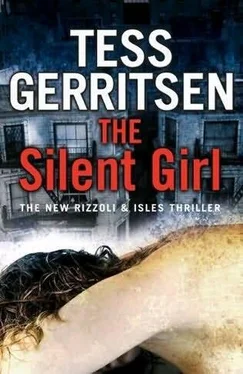A long pause, then he lifts the blade from my skin. “Let’s make a deal,” he says calmly. “You tell me who this witness is. And I’ll tell you what happened to your daughter.”
I try to process what he’s just said, but the darkness suddenly spins around me and the floor seems to be dissolving beneath my feet. He sees my confusion and he laughs.
“You had no idea, did you, that this was always about her. Laura, wasn’t that her name? She was about fourteen years old. I remember her, because she was the first one I got to choose. Pretty little thing. Long black hair, skinny hips. And so trusting. It wasn’t hard to talk her into the car. She was carrying all those heavy books and her violin, and was grateful for the ride home. It was all so easy, because I was a friend.”
“I don’t believe you.”
“Why would I lie?”
“Then tell me where she is.”
“First tell me who the witness is. Tell me who was in the Red Phoenix. Then I’ll tell you what happened to Laura.”
I am still struggling with this revelation, trying to understand why this man knows my daughter’s fate. She disappeared two years before my husband died in the shooting. I never imagined any connection between the events. I had believed that fate simply delivered a double blow, a karmic punishment for some cruelty I’d committed in a past lifetime.
“She was such a talented girl,” the smooth voice says. “That first day we rehearsed, I knew she was the one I wanted. Vivaldi’s Concerto for Two Violins. Do you remember her practicing that piece?”
His words are like a blast that hurls shrapnel through my heart because I know now that he’s telling the truth. He heard my daughter play. He knows what happened to her.
“Tell me the name of the witness,” he says.
“This is all I’ll tell you,” I say quietly. “You are a dead man.”
The blow comes without warning, so violent that it whips my head backward and my skull slams against the wall. Through the roaring in my ears I hear him speaking to me, words that I don’t want to hear.
“She lasted seven, maybe eight weeks. Longer than the others. She looked delicate, but oh, she was strong. Think of it, Mrs. Fang. For two whole months, while the police were searching for her, she was still alive. Begging to go home to her mommy.”
My control shatters. I cannot stop the tears, cannot suppress the sobs that rack my body. They sound like an animal’s howls of pain, wild and alien.
“I can give you closure , Mrs. Fang,” he says. “I can answer the question that’s been tormenting you all these years. Where is Laura?” He leans in closer. Though I can’t see his face, I smell his scent, ripe with aggression. “Tell me what I want to know, and I’ll put your mind at rest.”
It happens before I even think about it, a feral reaction that surprises us both. He flinches away, gasping in disgust as he wipes my spit from his face. I fully expect that another blow will follow and I brace myself for the pain.
It does not come. Instead he bends down and picks up my tracking device, which he had earlier tossed to the floor. He waves it in my face. “Really, I don’t need you at all,” he says. “All I need to do is replace this battery and turn it on again. And I’ll just wait to see who shows up.”
He leaves the room. I hear the door swing shut, and footsteps thud up the stairs.
Grief is my only companion, gnawing with teeth so sharp that I cry and flail against the manacles, scraping skin from my wrists. He had my daughter. He kept her. I remember the nights after Laura vanished, when my husband and I clung to each other, neither daring to say what we were both thinking. What if she is dead? Now I realize there was a far worse possibility, something that we had not imagined: that she was still alive. That during those two months, as James and I felt hope die and acceptance take its place, our Laura was still breathing. Still suffering.
I slump back exhausted, and my screams fade to whimpers. The frenzy has left me numb. Leaning against the concrete wall, I try to reconcile what he has just told me with what I already know, which is this: Two years after my daughter’s abduction, my husband and four other people were massacred in the Red Phoenix restaurant. How could these events be related and what ties them together? This he never explained.
I struggle to remember everything he said, searching through the fog of grief for clues. One sentence suddenly comes back to me, words that instantly freeze the blood in my veins.
She lasted seven, maybe eight weeks. Longer than the others .
My head lifts at the revelation. The others .
My daughter was not the only one.

WHAT DID DETECTIVE INGERSOLL KNOW, AND WHY WAS HE killed for it?
That was the question that consumed Jane as she sat late into the afternoon, sifting through her notes about Ingersoll’s murder. Spread across her desk were the crime scene photos of his residence, ballistic and trace-evidence reports, his cell phone and landline logs, and his bank card charges. According to Donohue, a death contract had gone out on Ingersoll weeks ago, right about the time when he began asking questions about missing girls. All the cases were old ones that had since dropped off the radar of departments across Massachusetts. She stared at a photo of Ingersoll’s body and thought: What monster did you awaken?
And what do missing girls have to do with the Red Phoenix?
She reached for the files on those missing girls. She was thoroughly familiar with the details of Laura’s and Charlotte’s disappearances, so she focused on the other three cases. All the victims were pretty and petite. All were good-to-excellent students. All were multitalented.
Patty Boles and Sherry Tanaka played in tennis tournaments. Deborah Schiffer and Patty Boles participated in art fairs. Deborah Schiffer played the piano in her school orchestra. But none of the three knew one another, at least according to their parents. And they were different ages at the times of their disappearances. Sherry Tanaka was sixteen. Deborah Schiffer was thirteen. Patty Boles was fifteen. One in middle school, two in high school.
Jane thought about this for a moment. Remembered that Laura Fang was fourteen years old when she vanished.
She jotted down the order in which the girls disappeared.
Deborah Schiffer, age thirteen.
Laura Fang, age fourteen.
Patty Boles, age fifteen.
Sherry Tanaka, age sixteen.
Charlotte Dion, age seventeen.
It was like staring at a royal flush. Every year, a different girl, a different age. As if the kidnapper’s taste had matured as the years passed.
She reached for the folder with the last photos of Charlotte, taken at the double funeral of her mother and stepfather. Again she flipped through the sequence of images taken by the Boston Globe photographer. Charlotte looking pale and thin in her black dress, surrounded by mourners. Charlotte stumbling away toward the edge of the crowd as Mark Mallory, her stepbrother, stares in her direction. The photo where Charlotte and Mark are absent, and her father, Patrick, looks confused by the sudden abandonment. Finally she came to the last image, where both were back in the frame, Mark walking behind Charlotte. Tall and broad-shouldered, he could easily have overpowered his stepsister.
Every year, an older girl.
The year that thirteen-year-old Deborah Schiffer vanished was a year after Dina and Arthur Mallory married, forming a new and reconstituted family, with all the joint activities that this would have entailed. School assemblies. Orchestra performances. State tennis tournaments.
Читать дальше













